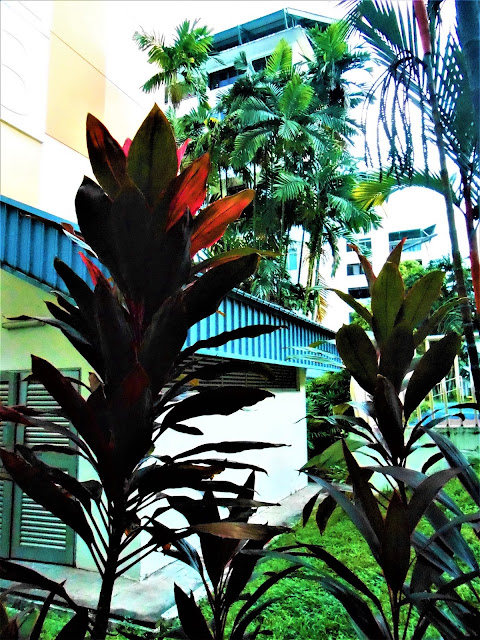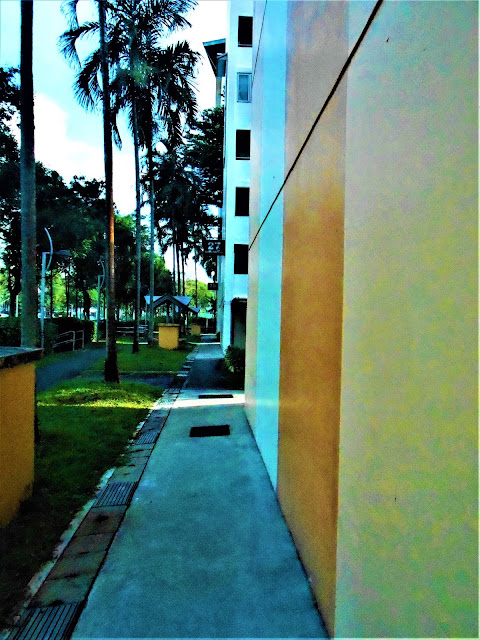My original plan had been to complete the visit to Tanglin Hat within a day, but, having not known just how large the estate was, I'd completely underestimated the time, and so it was that I found myself back at Commonwealth MRT the very next day.
The route I took to enter the estate was a little different this time, where instead of starting from the back of Sheng Siong Supermarket like I'd done the day before, today I went over to the Queensway side and started from there.
Why, you might ask.
Simply put, I was curious.
See, Commonwealth Avenue West (along which the MRT line runs) might be considered a 'new' road in the history of the this town and the towns down the road, but Queensway, however, is not.
Again, it might not always have been called Queensway (that name probably didn't appear until Queenstown Housing Estate was formed) but this route likely existed at a time when there was no housing estate, no MRT line, no shops, no public swimming pool, nothing, except for these towering stable, safe-looking structures rising up impressively from (cleared) forested, hilly ground.
This is no old road, not when it stretches from the south side of the country (think Portsdown and/or Southern Ridges) all the way to one end of the Central Catchment Area at the Macritchie Reservoir side.
The road fascinated me.
So I decided to feel how it was like to be accessing the estate from the Queensway side.
One thing that surprised me was just how close to the Queensway route it was.
Estates in the 70s and 80s are built in such a way that there's a little distance between your house, and the main road. Even if your blocks faces the avenue, there's always a patch of grass, a pathway, or a drain that you have to cross.
Here there was none.
Up a small staircase from the back of the bus stop and right away I was standing (almost) outside the back door of someone's ground floor home.
It would be perceived as a severe lack of privacy these days but the world then was perhaps a little more communal than they are now.
Maybe it was meant to be a replica of the kampongs.
Maybe it was meant to foster togetherness and familiarity.
I don't know- we can't say for sure what life was really like at that time- but the way the blocks were arranged certainly made me feel like community interaction was a way of life.
It's not that they were tightly cloistered together or that they were compact. It was just that they were so close knit that you could simply have a conversation with your neighbor on the right and left by simply leaning your head outside the window.
I have to say that the apartments on the ground floor intrigued me a little.
They weren't like the typical ground floor apartments I was used to seeing.
Maybe it was the way the land was laid, but what I'd initially thought was the first floor (with the lift) turned out to be the second floor because behind the letter boxes were a little slope and staircase leading down to the flats on what was really the ground floor.
Some corridors looked out to the back door of their neighbors in the opposite block. Some corridors faced each other.
It was very interesting, I thought, what with the way a person lived, where there was little, if no, distinction between your own (private) life, and that which you presented to the world. Where you might have shown one neighbor your formal work clothes, to another you would have shown your comfortable home clothes, your laundry, and the way you lived at home.
Again, I cannot say for certain that this was how life was like in the years that the residents stayed here.
It is impossible to compress the life of decades into a single day.
I found myself wondering how their day to day lives had been like.
Did they take their daily morning exercise around the blocks before making their way to the shops or to the Tanglin Halt Market and Food Centre?
Did they potter about at home most of the time except to go with family and loved ones to the town center across the road for the hawker center, the cinema, the shopping center, maybe the library?
Or were they happy to just walk out to the common corridor outside their home to look at the blocks of Stirling Road and Mei Ling Road close by?
It is now impossible for (late) visitors like me to know.
And maybe it's also hard for them to say.
No one wants to talk about the day when they shut the door and walk away from their home for the last time.
No one wants to talk about the neighbors and friends whom they don't know if they'll ever meet again.
And no one wants to forget the way the sun shines into their home.
There may come a day where the sun will no longer slant her golden rays upon the walls of a block but instead cast them upon the tinted windows of a much taller housing block.
There may come a day where we won't get to see the rays of the evening sun glow beautifully along the outside walls of someone's home.
Or that the trees won't throw their glorious shadows upon the benches and grasses between the pavements of the residents' homes.
But until that happens- until the day where, like their sisters on Margaret Drive, they become rubble- the sun will continue to rise on the eastern end of their walls, and will continue to cast her gentle, comforting golden light on the backyards and the little gardens once tended by those who dwelled there.


















